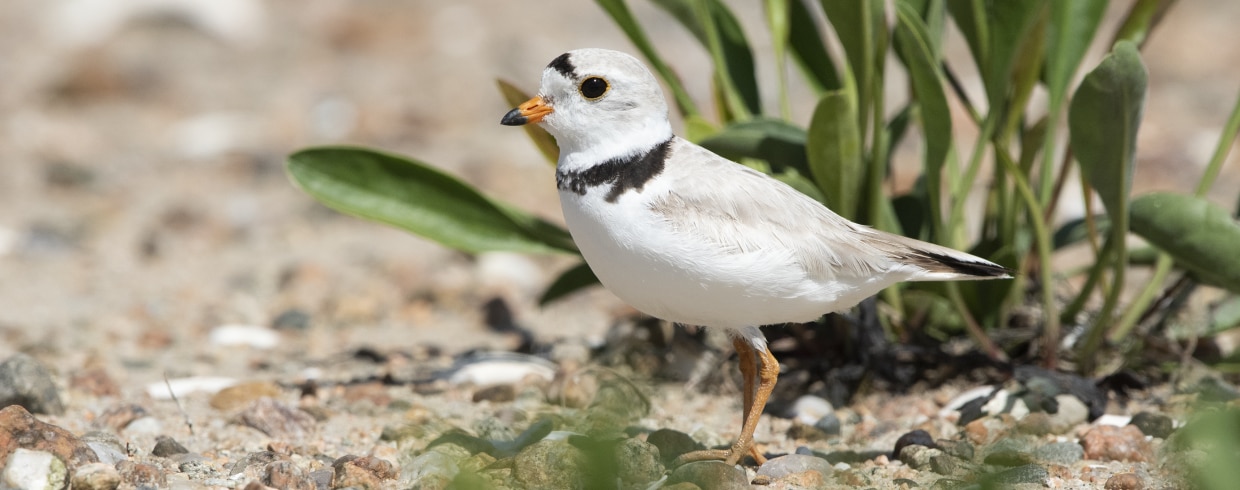Fast facts
Common name: Piping plover
Scientific name: Charadrius melodus
Size: 6–7 inches in length with a 14–16-inch wingspan
Range: Atlantic coast population nests from Newfoundland to North Carolina, winters from North Carolina to Florida, Gulf of Mexico, and Caribbean; Midwest population nests in northern Great Plains and Great Lakes area, winters along the Gulf of Mexico
Conservation status: Threatened within Massachusetts and federally
Fun fact: Most piping plovers return to the same nesting and wintering sites each year
Description
Piping plovers are small, stocky shorebirds. They are pale brown, gray, or sandy-colored on the backside. The underside, forehead, cheeks, and throat are white. A black streak extends from one eye to the other on the top of the head and a black breastband may not always form a complete circle. The tail is white at the base and tip, but dark in the middle. The legs and bill are yellow-orange. The bill has a black tip in the summer and turns completely black in the winter. Females have darker bills and lighter plumage than males.
Similar species: Semipalmated plovers (Charadrius semipalmatus) in size and shape, but are darker brown in color and have much more black on the head.
Population status
Massachusetts has the largest breeding population of piping plovers along the Atlantic coast, with 1,178 breeding pairs in 2023. Piping plovers are listed as threatened both on the Massachusetts and Federal Endangered Species Lists. There are three federally-recognized populations: the Atlantic Coast Population (threatened), the Great Lakes population (endangered), and the Great Plains population (threatened).
Conservation
In 1986, only 140 breeding pairs of piping plovers were in Massachusetts. The population has increased to 1,178 breeding pairs in 2023.
Massachusetts is a leader in piping plover conservation, thanks to the actions of beach managers and landowners. A habitat conservation plan for piping plovers was approved in 2016 to:
- Advance piping plover conservation through a variety of conservation actions that participants will be required to undertake
- Maintain and improve public access, recreational opportunities, and economic activity associated with the state's beaches
- Streamline the state and federal permitting process
Habitat
In Massachusetts, piping plovers nest on sandy, coastal beaches and dunes void of plants. They build nests in the narrow section of land between the high tide line and the foot of coastal dunes. Occasionally piping plovers will build nests on plant-covered or in eroded areas behind dunes. Piping plovers are also known to nest in least tern colonies.
Life history
Piping plovers live to at least 16 years old.
Piping plovers return to Massachusetts nesting sites in late March—April. Males establish territories and attract mates upon their return. Rival males mark off territories by running side by side down to the waterline. Nesting pairs will confront others that attempt to approach the nest. Males also defend feeding territories that include the coastal area adjacent to the nesting territory.
Males scrape shallow holes in the sand to create potential nest sites. A female then chooses which will be used. Nests are often lined with shell fragments and small pebbles. Females typically lay 4 eggs in a clutch. Both parents take part in incubating the eggs that hatch in 26–28 days.
Young chicks leave the nest within hours of hatching. When threatened, chicks run or lie motionless on the sand while their parents pretend to have a broken wing to distract the predator. Young plovers fledge 4–5 weeks after hatching. Winter migration starts between late July and early September.
Piping plovers feed primarily on marine worms, mollusks, insects, and crustaceans. They forage along the waterline, on mudflats at low tide, and in wrack—marine vegetation and debris washed up on shore at the high tide line.
More information
Learn more about piping plovers with our fact sheet.
Get an overview of the Massachusetts Endangered Species Act.
Contact
Online
Phone
Open M–F, 8 a.m.–4 p.m. (closed noon–12:30 for lunch)
North/Central/Western Massachusetts
Southeastern Massachusetts/Cape & Islands
